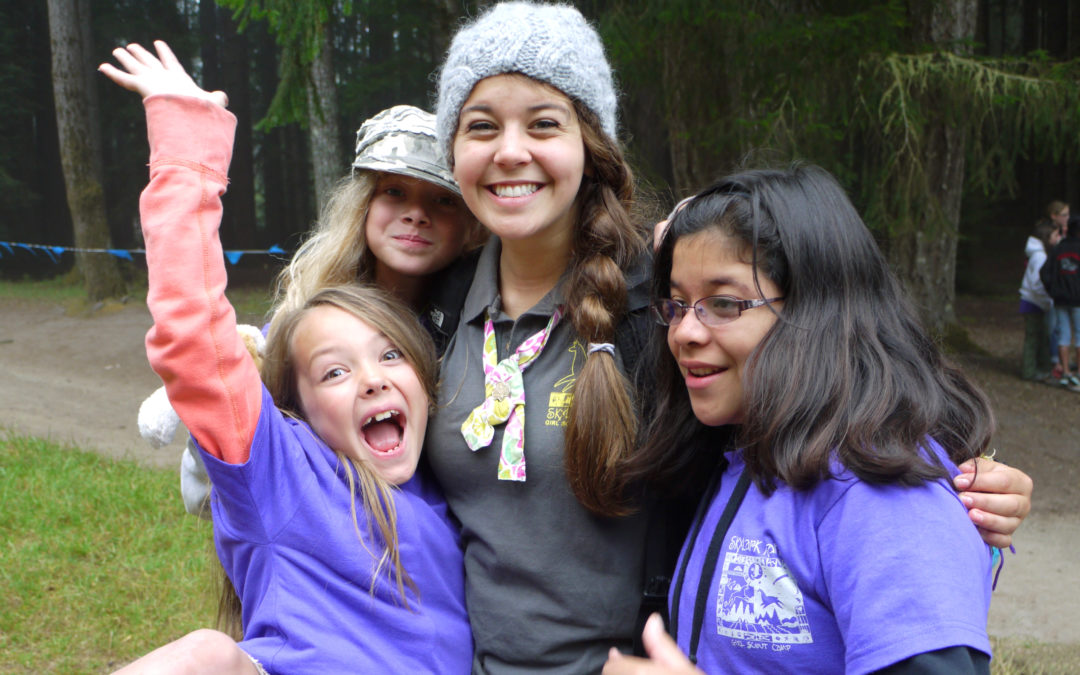Eliz “Apple” Adem is the camp director of Camp Skylark Ranch. It’s where she spent a lot of time as a Girl Scout, attending Service Unit Camporees, and completing her Counselor-In-Training (CIT) Program, which inspired her to pursue her desire to work with people and help others. The CIT program helps girls build foundational career skills and learn to work with girls of all ages. As they progress through the program, campers will get to learn about camp operations and program spaces, and then put their knowledge in to practice as they become an apprentice councilor to a unit of younger campers. To begin the CIT program, campers must be entering at least 10th grade and submit an application by April 1, 2019. Advanced and Apprentice CITS are contacted for an interview to help them practice the process of applying for a job. Here, Eliz shares her experience with the CIT program, and why she believes that leadership training is so important for every Girl Scout’s development.
I went to camp for the first time at the age of 15 in 2006. My family and I usually travelled internationally to visit my extended family, but that summer I was staying put in the Bay Area. My mom encouraged me to apply to the CIT program, and so I did. I had been to Skylark Ranch with my troop for Camporees, and I enjoyed working with younger kids, so why not? It was this summer that I picked my camp name “Apple.” Girl Scout camps around the nation have the tradition of staff using fun nicknames. I picked mine because I knew I wanted to work in the education field, it was short and sweet, and a name that people can pronounce confidently, unlike my legal name.
I credit my CIT experience with my foundation of knowledge when it comes to working with youth: how to lead songs, picking age appropriate games, remembering to bend your knees and make eye contact when talking to children, best approaches to managing homesickness, as well as methods to engage with children. I used these experiences when leading a Girl Scout troop of my own in college, tutoring children, volunteering as a docent for students at an art museum, and of course, when I began teaching in schools. When working with seasonal camp staff, these are all skills that are taught during our mandatory extensive ten-day staff training. Currently, CITs continue to learn the above skills, as well as participate in specialized workshops to learn more leadership styles, build up their song and game repertoire, and develop strong outdoor skills. CITs put their knowledge to the test by interacting with younger campers, mostly Brownies and Juniors.
The best parts of being a CIT are having responsibility and experiencing camp for yourself. I have vivid memories of creating a ninja bead hike for a group of Sea Stars campers, reading bedtime stories to Saddle Samplers, and collaborating with staff to put on a carnival themed All Camp. All Camp is a camp wide activity that occurs at least once during a session. As CITs we decided on the carnival theme, wrote the list of games that we would teach, rounded up supplies, set up, and then led the All Camp. This past summer, our CITs implemented our All Camp on July 4.
But being a CIT isn’t all responsibility and work. I remember still believing in Tajar, the Girl Scout Camp mascot—part tiger, part jaguar, part badger, that loves to swing in the trees and play pranks on campers such as stealing socks! My counselors put on a Tajar Party for us in the middle of Chapel Hill, surrounded by gusty winds and bright night time stars, and to this day I swear I heard Tajar rustling in the bushes. I remember heading to the Dining Hall thinking we were going to learn about kitchen operations, but were instead surprised by a DIY Spa evening with cheese, crackers, and hot chocolate. I remember laying on the floor of the Teepee unit (which is now Raven unit) talking with my peers until my counselors more than once had to tell us to stop and go to bed.
It was the best of both worlds: having special responsibilities, younger campers excited to see you, but still getting to be a camper and having counselors to admire. At the end of my CIT year, I counted down the days until next summer, eager to tell my friends at school how fun camp was, how I was surrounded by positive role models, and what cute campers I got to work with. It was only in college that I realized the best part was becoming a more confident version of myself, playing games and wearing clothes that I wouldn’t dream of daring to at school.
Camp can provide opportunities like collaboration, problem solving, and conflict resolution in different ways than schools can. Below the magnificent redwood trees that grow behind the English arena is my favorite spot at Skylark Ranch: Fern Grove. If you look hard enough, you can see forest fairies in the sky and underground gnomes building homes by the creek. This spot is where my least favorite moment as a Skylark Ranch camper occurred.
My CIT group was tasked to lash a bridge that went over the creek so that campers could use it to avoid getting wet and muddy feet. There were four of us to help make this project a reality. It took three times as long as it should have. Seven painstaking hours later, a bridge was complete, several arguments were mediated, and we all went to bed early emotionally exhausted. It took me five years to recognize and appreciate how incredible this learning experience was. In school, students are assigned group projects all the time. As a former teacher, I know that the projects usually are completed but do not necessarily involve the entire group. At camp that day, the whole group was involved and we had to face each other’s learning differences and personalities, and come out on top together.
Girl Scout camp is a sisterhood, and so is the CIT program, united by being supportive women role models to the next generation of campers and giving them a positive experience. I’m still in touch with my CIT peers, one of which I confide in a lot. 15-year-old me never would have guessed that I would have found my niche mentoring young adults, while working on behalf of children as a full-time Camp Director. I always tell my staff one thing: “I never promise anything. I will promise you this, though, if I had not had the opportunity to participate as a CIT at Girl Scout camp, I would not be an advocate for camp or for outdoor play and learning. At camp, you grow more in four days than you do in a whole school year.”
What to do next:
- Encourage your older girls to register for CIT! Summer 2019 registration is open at Camp Sugar and Camp Skylark Ranch.
- Learn all about GSNorCal camp programs, culture, values, and rules on our brand new camp website.
- Have more questions about camp life? Attend a Camp Info Night or meet your Camp Director at the Camp Director Office Hours!
 Eliz was introduced to the camp world through her Girl Scouting experience in the Northern California council. As a former classroom teacher, Eliz understands the responsibility in taking care of the whole child and takes pride in mentoring and developing staff members to be well trained caretakers, demonstrate professionalism, and to be engaging and positive role models. It was through her experiences as a unit counselor at Skylark Ranch and then as the Unit Manager & Assistant Camp Director at Camp Sugar Pine, Eliz embraced the positive impact camp has on developing confident and courageous children.
Eliz was introduced to the camp world through her Girl Scouting experience in the Northern California council. As a former classroom teacher, Eliz understands the responsibility in taking care of the whole child and takes pride in mentoring and developing staff members to be well trained caretakers, demonstrate professionalism, and to be engaging and positive role models. It was through her experiences as a unit counselor at Skylark Ranch and then as the Unit Manager & Assistant Camp Director at Camp Sugar Pine, Eliz embraced the positive impact camp has on developing confident and courageous children.


